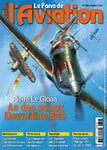Glenn Sprouse
Airman
Hello all!
I am doing a skin for War Thunder, (and marking the 1/48 Tamiya kit too) for Pierre Le Gloan's D.520 No.277. in GC.III/6. I was going to do three versions of the skin for War Thunder representing Battle of France, early armistice markings, and Vichy markings for Syria in June 1941. He had the same aircraft through all of that.
The problem started to arise with the markings when I took a good look at the photos. This photo, of his aircraft during the early armistice period, shows the issue I found.

There is a color on the nose between the spinner and the "arrow" end of the Vichy stripe. The stripe we know is white, as that was the directive of the Vichy Government for armistice aircraft. The spinner, when compared to the stripe, looks similar. The color between the two is different. Profiles generally don't show this color at all. They just show the normal camouflage. The handful of profiles that show the color have shown it as yellow, blue and natural metal.
Another photo shows a different angle and another aircraft, to the left, that appears to have color on the nose in the same place.

Eventually, the entire tail was painted yellow, but it also appears that the color on the nose was retained.

Profiles for the three periods show the following.

The Battle of France markings are the same in every reference I have. For the other two periods they miss or can't agree on the nose color and they also can't agree on the spinner color although that seems to be split between yellow or white.
My information on French markings during World War II is limited. I wanted to ask if there was anyone out there who could make a better guess at the nose and spinner colors than I could or has direct information about the markings here. I appreciate any help anyone can give me. Thanks!
I am doing a skin for War Thunder, (and marking the 1/48 Tamiya kit too) for Pierre Le Gloan's D.520 No.277. in GC.III/6. I was going to do three versions of the skin for War Thunder representing Battle of France, early armistice markings, and Vichy markings for Syria in June 1941. He had the same aircraft through all of that.
The problem started to arise with the markings when I took a good look at the photos. This photo, of his aircraft during the early armistice period, shows the issue I found.
There is a color on the nose between the spinner and the "arrow" end of the Vichy stripe. The stripe we know is white, as that was the directive of the Vichy Government for armistice aircraft. The spinner, when compared to the stripe, looks similar. The color between the two is different. Profiles generally don't show this color at all. They just show the normal camouflage. The handful of profiles that show the color have shown it as yellow, blue and natural metal.
Another photo shows a different angle and another aircraft, to the left, that appears to have color on the nose in the same place.
Eventually, the entire tail was painted yellow, but it also appears that the color on the nose was retained.
Profiles for the three periods show the following.
The Battle of France markings are the same in every reference I have. For the other two periods they miss or can't agree on the nose color and they also can't agree on the spinner color although that seems to be split between yellow or white.
My information on French markings during World War II is limited. I wanted to ask if there was anyone out there who could make a better guess at the nose and spinner colors than I could or has direct information about the markings here. I appreciate any help anyone can give me. Thanks!


